
Caguas is a city and municipality of Puerto Rico located in the Central Mountain Range of Puerto Rico, south of San Juan and Trujillo Alto, west of Gurabo and San Lorenzo, and east of Aguas Buenas, Cidra, and Cayey. Caguas was founded in 1775. The municipality had a population of 127,244 at the 2020 census.
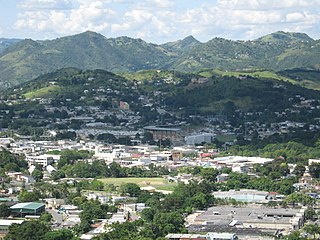
Cayey, officially Cayey de Muesas, is a mountain town and municipality in central Puerto Rico located on the Sierra de Cayey within the Central Mountain range, north of Salinas and Guayama; south of Cidra and Caguas; east of Aibonito and Salinas; and west of San Lorenzo. Cayey is spread over 21 barrios plus Cayey Pueblo. It is part of the San Juan-Caguas-Guaynabo Metropolitan Statistical Area.

Comerío is a town and municipality of Puerto Rico in the center-eastern region of island, north of Aibonito; south of Naranjito and Bayamón; east of Barranquitas; and west of Cidra and Aguas Buenas. Comerío is spread over 7 barrios and Comerío Pueblo. It is part of the San Juan-Caguas-Guaynabo Metropolitan Statistical Area.

The Escuela de Artes Plásticas y Diseño de Puerto Rico is an institution of higher learning engaged in the training of students in the visual arts. It is located in Old San Juan, San Juan, Puerto Rico. The school was founded in 1965 as part of the Institute of Puerto Rican Culture. Painter José Antonio Torres Martinó was one of the school's co-founders. The school's first director was Miguel Pou.

The Diocese of Caguas is a Latin Church ecclesiastical territory or diocese of the Catholic Church in the Caribbean, consisting of the southeastern portions of Puerto Rico in the United States. The diocese is led by Bishop Eusebio Ramos Morales whose seat is the mother church in the City of Caguas, Catedral Dulce Nombre de Jesús. The cathedral was built as a parish church in the 19th century.

Río Piedras is a populous district of San Juan, and former town and municipality of Puerto Rico, which was merged with the municipality of San Juan in 1951. The district today is composed of various barrios such as Pueblo and Universidad. The historic town was founded in 1714 as El Roble, it was given municipality rights in 1823, and since 1903 it has been the home of the University of Puerto Rico's main campus, earning the popular name of Ciudad Universitaria today. The downtown and historic center of Río Piedras is officially known as the Pueblo barrio of the municipality of San Juan.
Parque Yldefonso Solá Morales is a baseball stadium in Caguas, Puerto Rico. It serves as the home field of the Criollos de Caguas. The stadium held 10,000 people. The hockey events for the 2010 Central American and Caribbean Games were held there. The stadium is named after the senator Yldefonso Solá Morales. In 2018, the stadium was closed and was expected to be demolished. However, a renovation plan was ultimately approved for the installation and was set to begin at end of 2021.
Coliseo Héctor Solá Besares is an indoor sporting arena located in Caguas, Puerto Rico. It is used mostly for basketball and was the home arena of Caguas Creoles of the National Superior Basketball league. The capacity of the arena is 10,000 spectators. Also the Coliseo is the home ground for Criollas de Caguas volleyball team from Liga de Voleibol Superior Femenino.
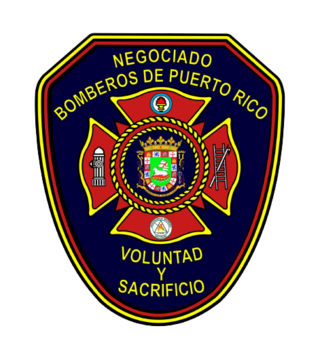
The Puerto Rico Firefighters Corps (PRFC); is the statewide fire department that provides fire protection, rescue, and protection from other hazards in the U.S. Estado Asociado Libre of Puerto Rico. It was established in 1942 under the Puerto Rico Fire Services. In addition, it offers fire protection services to all the airports under the authority of the Puerto Rico Ports Authority, Rafael Hernández Airport, and Mercedita Airport and they serve as crash rescue divisions. A separate agency, the Puerto Rico Medical Emergency Corps, provides emergency medical services to all Puerto Rico.
The Bairoa River is a river of Caguas, Puerto Rico.
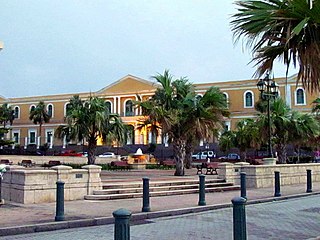
The Institute of Puerto Rican Culture, or ICP for short, is an institution of the Government of Puerto Rico responsible for the establishment of the cultural policies required in order to study, preserve, promote, enrich, and diffuse the cultural values of Puerto Rico. Since October 1992, its headquarters have been located at the site of the old colonial Spanish Welfare House in Old San Juan. The ICP was created by order of Law Number 89, signed June 21, 1955, and it started operating in November of that year. Its first Executive Director was Dr. Ricardo Alegría.

Campo Atlético Charles H. Terry or, simply, El Charles H. Terry, is the oldest continuously functioning athletic field and baseball park in Puerto Rico, and the second oldest in the Caribbean. The field is located in the city of Ponce and has a capacity of several thousand spectators. It is located next to the Francisco Pancho Coimbre Sports Museum.

Centro Cultural Carmen Solá de Pereira de Ponce is the cultural center of the city of Ponce, and is located at 70 Cristina street in the Ponce Historic Zone, in Barrio Tercero, Ponce, Puerto Rico. The Center is located in a structure designed in 1870, and it is currently used for educational and cultural activities as well as for art exhibits. Centro Cultural de Ponce was founded on 12 November 1963.

Anarchism as a social movement is one of the manifestations of the political left within the working classes of Puerto Rico, having its peak during the late 19th and early 20th century. Anarchism was predominantly present within, but not exclusive to, the working classes that emerged as the sociopolitical environment changed. The municipalities of Caguas and Bayamón were the epicenters of the movement. It was also recorded in other industrial centers, such as Ponce, San Juan, Arecibo, Cayey, Cidra, Juncos, Vega Baja, Utuado, Lares, Yauco and Mayagüez. Despite sharing some core values, Puerto Rican anarchism was heterogeneous in nature. In general, Puerto Rican anarchism was distinctly anti-organized religion, in particular against the Catholic Church that had retained considerable influence since the beginning of Spanish colonialism. Following the Treaty of Paris, it also grew to oppose American sovereignty, as it perceived that the island was being forced into servitude with an Americanization initiative, leading to distinct antiauthoritarian stances against both foreign and local politicians, the wealthy higher classes and American labor unions. However, on principle the anarchists opposed joining the independence movement.

Beatriz is a barrio in the municipality of Caguas, Puerto Rico. Its population in 2010 was 4,353.

Caguas Pueblo is a barrio and downtown area that serves the administrative center (seat) of the city and municipality of Caguas, a municipality of Puerto Rico. It is bordered by the Cagüitas River to the north and located two miles southwest of the Grande de Loiza River. Its population in 2010 was 22,406.
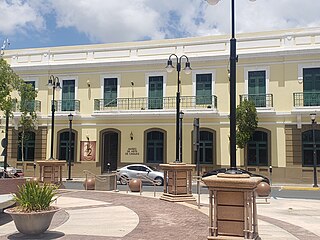
The Caguas Museum of Art is an art museum in Caguas Pueblo, the downtown and administrative district of the municipality of Caguas, Puerto Rico. The first level of the museum is dedicated to Caguas native painter Carlos Osorio and the second level offers temporary exhibitions. The entrance is free and guided tours are available. The museum also host cultural events.
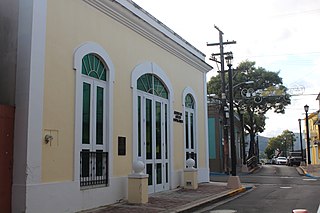
The Caguas Museum of Folk Arts is an art museum located in Caguas Pueblo, the downtown and administrative area of the municipality of Caguas, Puerto Rico.

The Caguas Museum of History is a history museum located in the old city hall of the municipality of Caguas, Puerto Rico. This building is located on Muñoz Rivera Street on the western edge of Plaza Palmer, the main town square. Caguas Pueblo, which is the historic and administrative center of the municipality.

Altos de San Luis, also known as Monte Altos de San Luis, is an 886 feet high and two-mile-long prominent mountain ridge located on the northern edge of the Caguas Valley, in barrio (district) Bairoa of Caguas, Puerto Rico. The ridge is bordered by the Loíza River to the north and the east, and it forms part of a larger system of mountain ridges that extends from the southwestern end of the Sierra de Luquillo in Gurabo to the northeastern end of the Cordillera Central in Aguas Buenas. Other mountains and hills along this system include the Altos de La Mesa and Cerro La Marquesa. These ridges are shaped by the Great Northern Puerto Rico fault zone (GNPRfz), an active fault zone which crosses the island diagonally from southeast to northwest.
















